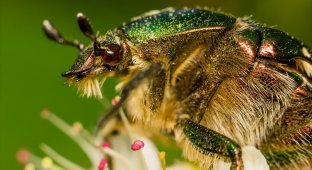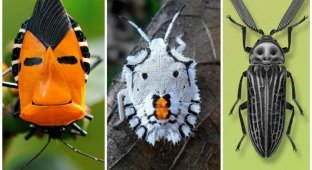Let's talk today about the largest beetle in Europe (and the second largest in Russia). Namely about the stag beetle.

A little biology
The stag beetle (lat. Lucanus cervus) belongs to the phylum arthropod, class insects, genus Lucanus of the stag beetle family. He holds the palm in Europe, he is considered the largest beetle, males reach an average of 70-74 mm, and females 25-57 mm in length.

Depending on their habitat, these beetles have significant differences in size. The body of the stag beetle is quite large and consists of a head, chest and abdomen. There are 3 pairs of legs on the chest. The abdomen is completely covered by elytra. The mandibles of males are much more developed than those of females. The lower body, head, legs, pronotum and scutellum of the insect are black. At the same time, the mandibles, that is, the horns, in males are red-brown or brown. The beetles have antennae and eyes on their heads.

The stag beetle lives in forests and oak groves of Europe, Kazakhstan, Iran, Asia, Turkey, and North Africa. These insects prefer deciduous trees, mainly oaks, but are sometimes found on trees such as poplar, pine, ash, beech, and linden. The stag beetle lives in oak forests, deciduous forests in floodplains, artificial parks and gardens, on plains and in the mountains.

Mating of stag beetles occurs on a tree within 2-3 hours. The male holds the female with his mandibles all this time. A female stag beetle lays up to 20 eggs, gnawing out special chambers for them in the bark of rotten trees. The eggs are oval in shape, light yellow in color and about 3 millimeters long. The larvae remain in the egg stage for a maximum of 6 weeks. The stag beetle larva is cream-colored. It is curved in a fetal position and by the end of its development reaches almost 14 centimeters.

Most often, the larvae are found in the roots of old, rotting trees, stumps, and very rarely on branches. There are no larvae in diseased but living trees. They feed exclusively on dead wood. They can also very rarely be found in fruit trees. English oak is their favorite place. Depending on the climate, the larva can develop differently. The development cycle of a stag beetle larva lasts from 4 to 6 years, in some cases even 8.

The main diet of stag beetles is plant sap. They gather in large groups near a wound on the tree bark and lick the juice, lapping it with their lower lip. The meal can last several hours. Sometimes beetles bite into young shoots and then consume the juice. At home, stag beetles are kept in a box with grass and soil. To feed them, sugar syrup is enough, to which you can add honey or juice.

Interesting Facts
- The documented record length of a male of the nominate subspecies caught in Europe was 95 mm. Males of the subspecies Lucanus cervus akbesianus and Lucanus cervus judaicus living in Turkey and Syria can reach lengths of up to 100-103 mm.
- Often these beetles can enter into fights with representatives of their own species - often the cause of fights is places where sap flows out of trees.
Having very strong mandibles, during such fights they are able to pierce the elytra, which are distinguished by their hardness, and sometimes even the enemy’s head.
To intimidate, they straighten their “horns”, taking a characteristic pose; if this has no effect on the opponent, the beetles make a swift attack, trying to pick him up from below.
As studies by various scientists show, it is the beetle that is in the fight below its opponent that wins, throwing it down from the branch.

- The stag beetle bites. Females can bite with short jaws. The bite force is enough to bite through a person's finger.
- In the bark of trees, the stag beetle larva can survive in severe frosts down to minus 20 degrees. The development of the larvae is greatly influenced by environmental humidity. When there is little moisture, the beetle develops slowly. If the larva pupates in October, the adult beetle appears between May and July.
- Stag beetle larvae are endowed with a unique feature - they produce sounds at a frequency of 11 kHz, which ensures their communication with each other.
- This species also has many enemies, most of which are birds. Having eaten exclusively the belly of the insect, they leave behind its mandibles and exoskeleton. Because of this, in the autumn, when walking through the forest, a large number of remains of deer beetles are discovered. There is also information that eagle owls eat them along with the head.
- Female stag beetles are less prone to flight than males. Beetles fly mainly over short distances, although sometimes they are capable of moving 3 km.

- The beetle's flight is quite fast and controlled. A very steep climb and a sharp rise in altitude are possible.
- The flight of the beetle continues from the last days of May until July. They are active at different times of the day, depending on the habitat - in the north of their range, beetles manifest themselves mainly at night, hiding in trees during the day with sap flowing out of them. Meanwhile, in the southern part, insects are active mainly during the day.
- It’s interesting that this species is not always able to take off from a horizontal plane; sometimes it may take several attempts. They also cannot fly in temperatures less than 17 degrees.
- When flying, the stag beetle insect holds its body almost vertically, since the stag beetle's antlers greatly outweigh it.
- Throughout their lives they do not eat, but only suck the sap secreted by trees or bushes. The lifespan of adult stag beetles is three to four weeks, less often about two months.
- The ancient Romans believed that amulets consisting of their beetle horns could save them from misfortune and misfortune. They wore necklaces themselves and encouraged their children to do the same as their ancestors.
- In medieval Europe, it was believed that beetles fly over villages at night, holding a burning coal in their horns and throwing it onto the thatched roofs of houses.
- In 1997, Poland issued a 2 zloty coin made of bronze with the image of a stag beetle. There is also a type of coin with this image, made of silver, with a denomination of 20 zlotys.

- It is interesting that male larvae form a cocoon with a reserve of space for future “horns”.
- The disappearance of the stag beetle is mainly associated with the cutting down of oak forests. But it is known that the larvae of this beetle can develop in the dead wood of 14 other tree species, including willow, beech, birch, linden, hornbeam, pear, and poplar.
- Dried stag beetle still remains an indispensable accessory to the traditional national costume of the Bavarians.

- The strength of beetles is amazing - in the experiment they lift a weight one hundred times greater than their own. It’s no wonder that with such strength, opponents’ shells often end up dented and even pierced - just like in a real knightly tournament.
- Their vitality is simply amazing. Even the head, separated from the body, can still see for a long time and bite another beetle brought to it with the same force.
- The name of this insect sounds different in different languages. But it always included the word “deer.”
- In the Middle Ages, wonderful properties were attributed to this beetle. It seemed to attract lightning (remember, lightning especially often strikes huge and old, free-standing trees, and especially many stag beetles fly around the crowns of such oaks).
- The stag beetle was glorified by the German artist Albert Durer (1471-1528). He drew a life-size stag beetle. This drawing was sold for 175,000 German marks in the 70s of the 20th century.
- In one scientific laboratory, studies were carried out in which a young beetle was forced to hatch prematurely. This can be done by freezing the pupa and then placing it in a warm place. This is how the temperature difference between winter and summer is repeated, which leads to the “awakening” of the young individual.
- In Transnistria in 2006, a silver coin worth 100 rubles was issued with the image of a male and female stag beetle. It is worth noting that the inscription on the coin contains a mistake in the generic name - “Lukanus” instead of “Lucanus”.

Conclusion.
In central Europe at that time, the stag beetle was common. In recent decades, its numbers have been steadily declining. There are several reasons for this. Firstly, the development of larvae takes place in old, dying or already dead trees, and with modern forestry methods, trees are rarely allowed to live to old age; a fallen oak or beech is immediately sawed up and taken away. The disappearance of natural habitats is the main reason for the decline in the number of these beetles both in Western Europe and in our country. In addition, when chemically treating forests, pesticides fall on tree trunks and on the sap flowing from them, and the feeding stag beetles die. Conservation measures for this type of insect can only be the preservation of its inherent biotopes in their original state, in particular the creation of entomological reserves in the territory of oak forests and other forests with an admixture of oak; preservation of individual old-growth oak trees.

P.S.
I hope you liked it. And I wanted to ask, if there are beekeepers among the readers, then I would like to know the opinion on the video which will be the last. Is this a bug addict or is this behavior normal?



























